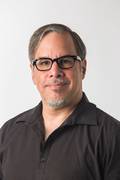It’s kind of difficult to succinctly describe Ashanti McGee. On one level, it’s not hard at all: She’s a painter, and a sublimely gifted one. (She’s also versed in drawing, illustration and sculpture.) Her piece for the 2019 Block 17 show at UNLV’s Donna Beam Gallery, “Neon as Oshun,” took an inherently kitschy medium, the black velvet painting, to an unexpectedly spiritual place with its luminous depiction of a Yoruba water goddess. It’s the kind of work that, once you’ve seen it, lives rent-free in your dreams.
Now, here’s where the CV deepens. McGee has a discerning eye for other artists’ work: She’s a co-owner, with husband Brent Holmes, of Mesa Gallery (instagram.com/gallerymesa), and recently curated A Common Thread, a group show featuring textile art by nine women artists of color, at the Barrick Museum. She’s the grants and access manager for the Western States Art Federation (WESTAF); is a Jameson Fellow with Compassionate Las Vegas, focused on education, health and other social issues; serves on the board of the Cultural Alliance of Nevada; formerly served as a District Representative for Las Vegas at the U.S. House of Representatives; and is a fiercely proud mother of four.
“I really enjoy pushing myself,” McGee says, adding with a chuckle, “and that’s probably something unhealthy that I need to address.”
Where are you from? I was born in Tuskegee, Alabama, at the actual Tuskegee Institute. I think, because of that, I have a science-and-art mind. My dad went to school there for African American Studies and he also dabbled in some art, and my mom went there for Animal Science. That probably explains a lot about my approach to things.
What was your first artistic medium? Goodness, it was anything and everything. When I was a kid I pretty much did whatever. I was trained at LVA for oil painting and printmaking; those are the two that I was really interested in. Now I’m getting more into sculptural and mixed media work.
And textiles. How did A Common Thread come to be? My family’s extremely matriarchal. … My grandmother worked at a Lutheran church in Washington, D.C., that made all different kinds of embroidered items; she made these embroidered altar cloths, and unfortunately, I don’t have any of them. She did it all on machine, but she taught my mom how to do it by hand, and I know how to dabble in it. … There’s so much that goes into creating something with your hands. You’re physically no longer there, but there’s that remnant of you, of you creating. You know, I wonder what people are doing and thinking as they’re going through this methodical, rhythmic process of making. I love the idea of artists hitting that zone to where it’s just complete nothingness; it just goes and it flows.
How often do you get into that zone? I haven’t had time to do art lately! Every once in a while, I’ll do a little picture or doodle somewhere. I need space and time: I need time to get to the space that I need to be in. I have a show that I’m working on in my head right now. It’s going to focus on the complexities of being a Black woman. It’s about reflections of myself, about looking at women around me and the things that you have to deal with. I’m hoping to get to lighter stuff soon, but I’m not ready yet (laughs).
You’re an advocate for the arts in Las Vegas. How’s that going? I’m really trying to focus on connecting artists and arts organizations to resources or policy that allows artists to do work more effectively and more efficiently. … You know, I grew up with museums all around me. Even though I lived in New Jersey, we’d go to Philadelphia all the time and just immerse ourselves in museums. My children, and so many other children here, don’t have that. My family will go on a bender in LA, spending two days on museum tours. We’re like, “OK, can we get in five museums in two days?”
For a long time, the arts was marginalized in Las Vegas—as if it didn’t belong in daily life. Exactly. There are so many people here that come from other cities where the arts are so much part of their lives, not compartmentalized. Art really can be incorporated into so many other things that we do. One of those things that I really advocate for is the fact that the arts is an easy and effective way of problem solving, and learning about the world around you.
Now seems a good time to ask about your fascination with earth. Like, actual earth; soil and rocks. Again, Tuskegee. I’ve been collecting rocks since I was probably 5 or 6. I was really into crystals but also knowing the difference between metamorphic and sedimentary rocks, and how those formations look. I’m hoping that the next iteration of reinventing myself is me really getting into the sciences.
As for soil … I just really like [taking] things that are seemingly mundane or uninteresting and making them interesting. I think that’s a little more of who I am: For the longest time, throughout the arts, a lot of people didn’t see me as “the artist.” It was always about being part of organizations and working in the back of the house. And I really like the idea of supporting and helping artists, but I finally I feel like I’ve come to a point where I really want to pursue things that I’m actually talented in.









